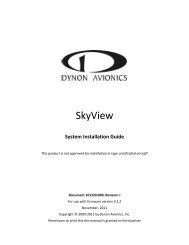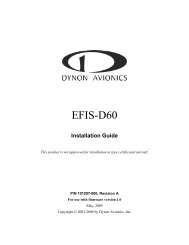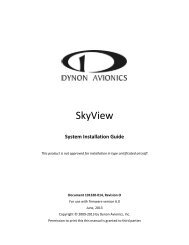EFIS-D100 Installation Guide - Dynon Avionics
EFIS-D100 Installation Guide - Dynon Avionics
EFIS-D100 Installation Guide - Dynon Avionics
Create successful ePaper yourself
Turn your PDF publications into a flip-book with our unique Google optimized e-Paper software.
Autopilot <strong>Installation</strong> and Configuration<br />
Repeat the AP-commanded climbs/descents and torque adjustments until the ALT indicator does<br />
not display a slip indication.<br />
Continue performing AP-commanded climbs and descents, and observe the overall behavior of<br />
the aircraft. If the aircraft oscillates in holds or overshoots as it reaches target altitude, that is an<br />
indication that the Pitch Servo SENSITIVITY needs to be increased. If, upon reaching the target<br />
altitude the stick “twitches” excessively, that is an indication that the Roll Servo SENSITIVITY<br />
needs to be decreased.<br />
You should be able to find a SENSITIVITY value that is acceptable for altitude holds,<br />
climbs, and descents in smooth air. You may, however, find that in periods of extended<br />
turbulence, a lower SENSITIVITY value must be set.<br />
Step 9h – Verify AIRSP MIN/MAX, and VSPD MAX settings during altitude changes<br />
During an AP-commanded climb, verify that the time to complete the climb matches your<br />
expectations given the setting for the VSPD MAX parameter. For example, when VSPD MAX is<br />
set to 500 ft/min, a 500-foot climb should take about 1 minute. If this is not the case, the climb<br />
rate may be limited by the AIRSP MIN parameter, and the ADD POWER message is displayed.<br />
Likewise, during an AP-commanded descent, verify that the time to complete the descent<br />
matches your expectations given the setting for the VSPD MAX parameter. If it does not, the<br />
descent rate may be limited by the AIRSP MAX parameter, and the DECREASE POWER<br />
message is displayed.<br />
If necessary, adjust the AIRSP MIN, AIRSP MAX, and VSPD MAX parameters as described<br />
above.<br />
At this point, all the parameters in the AP > PITCH SERVO menu are properly tuned.<br />
Step 9i – Execute several AP-controlled changes of altitude and observe the overall aircraft<br />
performance.<br />
There may be some interaction between Pitch Servo Torque and Pitch Servo Sensitivity settings.<br />
Repeat the above steps as necessary to achieve acceptably smooth overall AP response during<br />
altitude holds and changes.<br />
Step 9j – Observe and verify trim indications during altitude holds and changes<br />
Find an area with a lot of clearance above and below the aircraft’s altitude. With the AP<br />
disengaged, put the aircraft into neutral trim. Engage the AP in ALT mode (and HDG or TRK<br />
mode if desired) and allow the AP to maintain altitude (and heading, if engaged). Trim the<br />
aircraft nose down; the AP will maintain the target altitude, despite<br />
the nose down trim. Continue trimming nose down just until a<br />
yellow UP▲ indicator displays (and stays on) next to the AP status<br />
indicator at the lower left of the <strong>EFIS</strong> screen (shown at right). This<br />
indicator displays when the AP senses too much nose down trim. Trim the aircraft nose up until<br />
the indicator disappears. Disengage the AP to observe the state of the aircraft’s trim.<br />
Repeat the above procedure, trimming the aircraft nose up until the yellow DN▼ indicator<br />
displays (and stays on). Then, trim nose down until the indicator disappears.<br />
During turbulence and small bumps the trim indicator may flash on and off. Do not take action<br />
based on the trim indicator until it remains on for several seconds.<br />
<strong>EFIS</strong>-<strong>D100</strong> <strong>Installation</strong> <strong>Guide</strong> 6-29
















